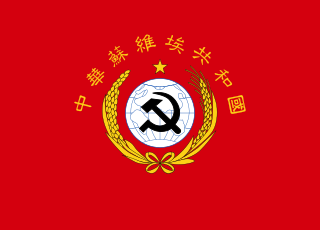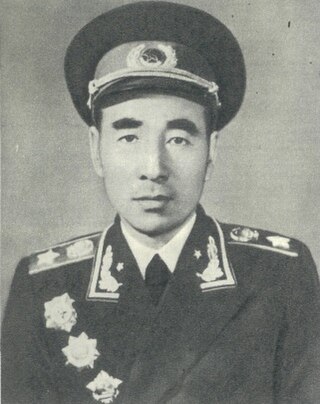
Mao Zedong was a Chinese politician, Marxist theorist, military strategist, poet, and revolutionary who was the founder of the People's Republic of China (PRC). He led the country from its establishment in 1949 until his death in 1976, while also serving as the chairman of the Chinese Communist Party during that time. His theories, military strategies and policies are known as Maoism.

Maoism, officially called Mao Zedong Thought by the Chinese Communist Party (CCP), is a variety of Marxism–Leninism that Mao Zedong developed to realize a socialist revolution in the agricultural, pre-industrial society of the Republic of China and later the People's Republic of China. The philosophical difference between Maoism and traditional Marxism–Leninism is that a united front of progressive forces in class society would lead the revolutionary vanguard in pre-industrial societies rather than communist revolutionaries alone. This theory, in which revolutionary praxis is primary and ideological orthodoxy is secondary, represents urban Marxism–Leninism adapted to pre-industrial China. Later theoreticians expanded on the idea that Mao had adapted Marxism–Leninism to Chinese conditions, arguing that he had in fact updated it fundamentally and that Maoism could be applied universally throughout the world. This ideology is often referred to as Marxism–Leninism–Maoism to distinguish it from the original ideas of Mao.

The Chinese Civil War was fought between the Kuomintang-led government of the Republic of China and the forces of the Chinese Communist Party, with armed conflict continuing intermittently from 1 August 1927 until 7 December 1949, resulting in a Communist victory and subsequent control of mainland China.

The Long March was a military retreat by the Chinese Red Army from advancing Nationalist forces during the Chinese Civil War in 1934 through 1936.

The time period in China from the founding of the People's Republic in 1949 until Mao's death in 1976 is commonly known as Maoist China and Red China. The history of the People's Republic of China is often divided distinctly by historians into the Mao era and the post-Mao era. The country's Mao era lasted from the founding of the People's republic on 1 October 1949 to Deng Xiaoping's consolidation of power and policy reversal at the Third Plenum of the 11th Party Congress on 22 December 1978. The Mao era focuses on Mao Zedong's social movements from the early 1950s on, including land reform, the Great Leap Forward and the Cultural Revolution. The Great Chinese Famine, one of the worst famines in human history, occurred during this era.

Zhu De was a Chinese general, military strategist, politician and revolutionary in the Chinese Communist Party.

Peng Dehuai was a Chinese military leader who served as China's defense minister from 1954 to 1959. Peng was born into a poor peasant family, and received several years of primary education before his family's poverty forced him to suspend his education at the age of ten, and to work for several years as a manual laborer. When he was sixteen, Peng became a professional soldier. Over the next ten years Peng served in the armies of several Hunan-based warlord armies, raising himself from the rank of private second class to major. In 1926, Peng's forces joined the Kuomintang, and Peng was first introduced to communism. Peng participated in the Northern Expedition, and supported Wang Jingwei's attempt to form a left-leaning Kuomintang government based in Wuhan. After Wang was defeated, Peng briefly rejoined Chiang Kai-shek's forces before joining the Chinese Communist Party (CCP), allying himself with Mao Zedong and Zhu De.

The Chinese Soviet Republic (CSR) was a state within China, proclaimed on 7 November 1931 by Chinese Communist Party (CCP) leaders Mao Zedong and Zhu De in the early stages of the Chinese Civil War. The discontiguous territories of the CSR included 18 provinces and 4 counties under the communists' control. The CSR's government was located in its largest component territory, the Jiangxi Soviet. Due to the importance of the Jiangxi Soviet in the CSR's early history, the name "Jiangxi Soviet" is sometimes used to refer to the CSR as a whole. Other component territories of the CSR included the Northeastern Jiangxi, Hunan-Jiangxi, Hunan-Hubei-Jiangxi, Hunan-Western Hubei, Hunan-Hubei-Sichuan-Guizhou, Eyuwan, Shaanxi-Gansu, Sichuan-Shanxi, and Haifeng-Lufeng Soviets.

Lin Biao was a Chinese politician and Marshal of the People's Republic of China who was pivotal in the Communist victory during the Chinese Civil War, especially in Northeast China from 1946 to 1949. Lin was the general who commanded the decisive Liaoshen and Pingjin campaigns, in which he co-led the Manchurian Field Army to victory and led the People's Liberation Army into Beijing. He crossed the Yangtze River in 1949, decisively defeated the Kuomintang and took control of the coastal provinces in Southeast China. He ranked third among the Ten Marshals. Zhu De and Peng Dehuai were considered senior to Lin, and Lin ranked directly ahead of He Long and Liu Bocheng.
People's war or protracted people's war is a Maoist military strategy. First developed by the Chinese communist revolutionary leader Mao Zedong (1893–1976), the basic concept behind people's war is to maintain the support of the population and draw the enemy deep into the countryside where the population will bleed them dry through guerrilla warfare and eventually build up to mobile warfare. It was used by the Chinese communists against the Imperial Japanese Army in World War II, and by the Chinese Soviet Republic in the Chinese Civil War.

Xu Xiangqian was a Chinese Communist military leader and one of the ten marshals of the People's Liberation Army. He was the son of a wealthy landowner, but joined the Kuomintang's National Revolutionary Army, against his parents' wishes, in 1924. When the Kuomintang (KMT) began to fight the Communists (CCP) in 1927, Xu left Chiang's forces and joined the Eyuwan Soviet on the borders of Hubei, Henan, and Anhui. There he became commander of the Fourth Red Army under Eyuwan's leader Zhang Guotao. When the Fourth Red Army was defeated by a Kuomintang encirclement campaign, Zhang and Xu retreated to northern Sichuan. After Zhang defected to the KMT in the late 1930s, Xu survived politically and rejoined the Red Army, in a less senior position, under the leadership of Mao Zedong.

He Long was a Chinese Communist revolutionary and one of the ten marshals of the People's Liberation Army. He was from a poor rural family in Hunan, and his family was not able to provide him with any formal education. He began his revolutionary career after avenging the death of his uncle, when he fled to become an outlaw and attracted a small personal army around him. Later his forces joined the Kuomintang, and he participated in the Northern Expedition.

The Yan'an Rectification Movement was a political mass movement led by the Chinese Communist Party (CCP) from 1942 to 1945. The movement took place in the Yan'an Soviet, a revolutionary base area centered on the remote city of Yan'an. Although it was during the Second Sino-Japanese War, the CCP was experiencing a time of relative peace when they could focus on internal affairs.

The Second United Front was the alliance between the ruling Kuomintang (KMT) and the Chinese Communist Party (CCP) to resist the Japanese invasion of China during the Second Sino-Japanese War, which suspended the Chinese Civil War from 1937 to 1945.
On Protracted War is a work comprising a series of speeches by Mao Zedong given from May 26, 1938, to June 3, 1938, at the Yenan Association for the Study of the War of Resistance Against Japan. In it, he calls for a protracted people's war, as a means for small revolutionary groups to fight the power of the state.

Xu Haidong was a senior general in the People's Liberation Army of China.

Communist-controlled China or the Revolutionary Base Area, officially called the Soviet Zone from 1927 to 1937, and the Liberated Zone from 1946 to 1949, was the part of the territories of China controlled by the Soviet-backed Chinese Communist Party (CCP) from 1927 to 1949 during the Republican era and the Chinese Civil War with Nationalist China.

The Chinese Communist Revolution was a social and political revolution that culminated in the establishment of the People's Republic of China in 1949. For the preceding century, China had faced escalating social, economic, and political problems as a result of Western imperialism, Japanese imperialism, and the decline of the Qing dynasty. Cyclical famines and an oppressive landlord system kept the large mass of rural peasantry poor and politically disenfranchised. The Chinese Communist Party (CCP) was formed in 1921 by young urban intellectuals inspired by European socialist ideas and the success of the Bolshevik Revolution in Russia. The CCP originally allied itself with the nationalist Kuomintang party against the warlords and foreign imperialist forces, but the Shanghai Massacre of Communists ordered by Kuomintang (KMT) leader Chiang Kai-shek in 1927 forced them into the Chinese Civil War spanning more than two decades.

The Chinese Red Army, formally the Chinese Workers' and Peasants' Red Army or just the Red Army, was the military wing of the Chinese Communist Party from 1928 to 1937. It was formed when Communist elements of the National Revolutionary Army splintered and mutinied in the Nanchang Uprising. The Red Army was reincorporated into the National Revolutionary Army as part of the Second United Front with the Kuomintang to fight against the Japanese during the Second Sino-Japanese War of 1937–1945. In the later stages of the Chinese Civil War they splintered off once again and renamed the People's Liberation Army.

Report on an Investigation of the Peasant Movement in Hunan or Inquiry into the Peasant Movement of Hunan of March 1927, often called the Hunan Report, is one of Mao Zedong's most famous and influential essays. The Report is based on a several month visit to his home countryside around Changsha, capital of Hunan in early 1927. The Report endorses the violence that had broken out spontaneously in the wake of the Northern Expedition, makes a class analysis of the struggle, and enthusiastically reports the "Fourteen Great Achievements" of the peasant associations (农民协会).

















